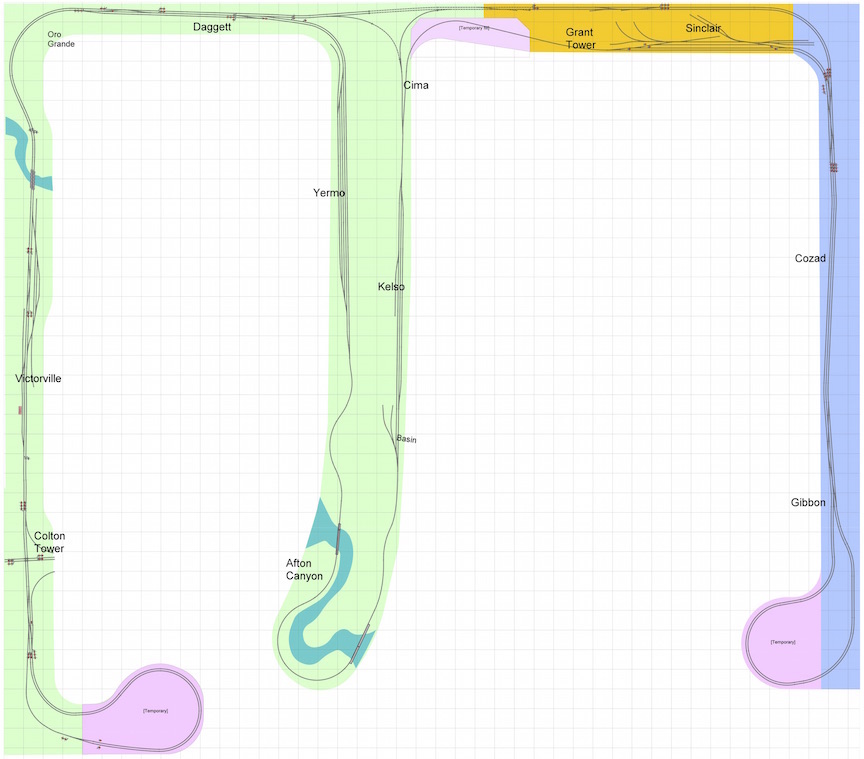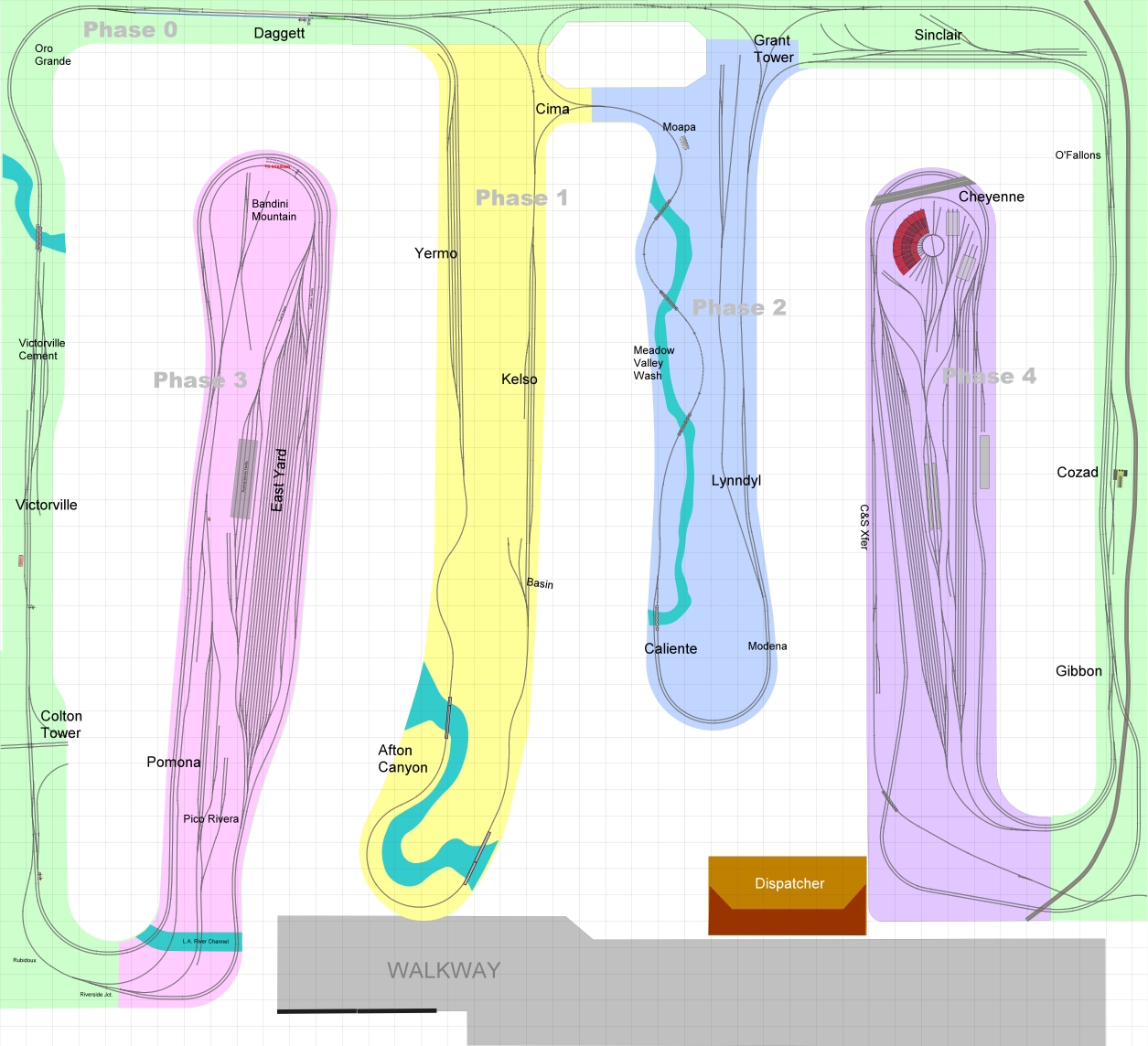Layout Construction Phases
Updated 3/30/2020
 Phase
0 is the backbone of the layout, with temporary sections
to create a "dogbone" configuration for continuous running. The
mainline portions are currently operational, and it takes
roughly 15 minutes for a train running at a prototypical speed
to circumnavigate the full plan as it stands.
Phase
0 is the backbone of the layout, with temporary sections
to create a "dogbone" configuration for continuous running. The
mainline portions are currently operational, and it takes
roughly 15 minutes for a train running at a prototypical speed
to circumnavigate the full plan as it stands.The layout design elements (LDEs) in Phase 0 start with Colton Tower at the bottom left, a loose representation of the ATSF+UP and SP crossing seeing the lion's share of rail traffic in and out of Southern California. The SP main is a scenic element only. We then jump north to Victorville, conveniently and mercifully skipping San Bernardino and Cajon Pass. The Victorville setting includes the cement plant at Leon and twin bridges over the Mojave River, one of the few locations where the river is consistently visible.
On the north side of the river is the sweeping curve at Oro Grande, where we get a glimpse of "B Hill" which in real life overlooks the large Santa Fe yard in Barstow, but we instead continue into sleepy Daggett, where the UP LA&SL line will split away from the Santa Fe main in Phase 1. On the layout the ATSF main will become a hidden jump to Salt Lake City and the plains representations on the right (east) side of the layout.
Passing through what will become Grant Tower in Phase 2, the backbone main passes by the refinery at Sinclair, then skips to the junction at O'Fallons and the start of representations of UP's triple-track across Nebraska. US30 will also be depicted here, paralleling the mainline the entire length of this peninsula.
Cozad is the location of a large grain elevator whose most notable feature is the giant "COZAD" painted on the south side of the silos, intended to be visible from I-80 one mile away. The grain elevator and its service tracks are represented here, albeit highly-compressed, but nonetheless creating operational interest and a convenient excuse for the fleet of grain hoppers on the layout.
Gibbon is where the Marysville Subdivision splits from the triple-track. In Phase 0 we're using the junction for a return loop which will remain until the Phase 4 peninsula is completed and can handle the turnaround traffic. The return lobe below Gibbon differs slightly from the illustration (see Phase 1 image) for easier transition to Phase 4 construction.
There are still several features in Phase 0 under construction. Landforms and scenery have just started, with emphasis on the east side of the layout. Ballasting is in progress on this section of the layout as well. While the many full crossovers are installed including switch machines, three are functional at the moment, Colton Tower, O'Fallons and Gibbon. These are sufficient for running and staging trains. The remainder are standing by for completion of electronic control assemblies.
 With
benchwork now under construction, the peninsula in Phase 1
is to represent portions of the Los Angeles & Salt Lake
(LA&SL) line through the Southern California desert.
Diverging from the Santa Fe at Daggett, Yermo will provide a
modest amount of train staging with several yard tracks ranging
from 10 to 15 feet long, plus a 25-foot-long siding. The south
end of Yermo quickly transitions into the rugged Afton Canyon
with its steep walls and numerous bridges, intended to be a
signature LDE.
With
benchwork now under construction, the peninsula in Phase 1
is to represent portions of the Los Angeles & Salt Lake
(LA&SL) line through the Southern California desert.
Diverging from the Santa Fe at Daggett, Yermo will provide a
modest amount of train staging with several yard tracks ranging
from 10 to 15 feet long, plus a 25-foot-long siding. The south
end of Yermo quickly transitions into the rugged Afton Canyon
with its steep walls and numerous bridges, intended to be a
signature LDE. Once through Afton, we then pass the gravel pits at Basin, although this feature currently drawn from the prototype may instead be freelanced to represent a different industry somewhat peculiar to the Mojave Desert, one of the three carbon black plants in the Antelope Valley (near Mojave) on the SP. The technology of carbon black manufacturing in the era being modeled was a smelly process, and the windy desert locations were selected to minimize the problem. These plants all closed in the 1980s.
 Another
significant LDE is Kelso, where UP built a large and very
attractive depot as a crew change point and also to support
helper operations over the Cima grade. The depot was notable for
its hotel and lunch counter for train crews, as well as its
operation into the early 1980s. The depot has been preserved
by the U.S. Park Service. A model of the Kelso depot and
depot grounds is almost finished and will be featured on the
layout.
Another
significant LDE is Kelso, where UP built a large and very
attractive depot as a crew change point and also to support
helper operations over the Cima grade. The depot was notable for
its hotel and lunch counter for train crews, as well as its
operation into the early 1980s. The depot has been preserved
by the U.S. Park Service. A model of the Kelso depot and
depot grounds is almost finished and will be featured on the
layout.Phase 1 buildout terminates with Cima, serving as a transition to the backbone and the temporary alternate mainline through Sinclair. Though the tunnel at Cima was bypassed in the 1960s, its existence was close enough to our modeling era to be useful as a return path for alternate routing returning trains to the west side of the layout, and eventually, Los Angeles after Phase 3 is constructed.
 Phase
2 is a continuation of the LA&SL past Las Vegas and
into southwestern Utah via the Meadow Valley Wash. This
particularly difficult section of railroad was subject to
controversy and dispute during construction in the 1890s as
competitors rushed to get ahead of each other for access and
rights-of-way. Much of the railroad has been rebuilt multiple
times on account of the narrow canyons funneling runoff from
desert storms into rapidly rising and rushing inundations.
Phase
2 is a continuation of the LA&SL past Las Vegas and
into southwestern Utah via the Meadow Valley Wash. This
particularly difficult section of railroad was subject to
controversy and dispute during construction in the 1890s as
competitors rushed to get ahead of each other for access and
rights-of-way. Much of the railroad has been rebuilt multiple
times on account of the narrow canyons funneling runoff from
desert storms into rapidly rising and rushing inundations.After the handoff from Phase 1 at Cima, Phase 2 begins at Moapa, at the (prototype's) southern end of the canyon. The wash and the several bridges and tunnels are compressed into a scenic depiction of heavy railroading through difficult terrain on the west (left) side of the peninsula. The canyon portion ends in Caliente, a railroad town featuring a large hot spring which still supplies the north end of town with hot water. UP's depot in Caliente is an imposing mission-style structure roughly twice as large as Kelso, and it is hoped somewhere along the line the lessons learned with the Kelso depot construction can be applied to model the Caliente station.
Caliente's siding is compressed into a continuation through the ghost town of Modena and into Lyndyll, where, on the prototype, the line splits into the two routes into the Salt Lake City area. On the layout, the left side of the split is used as future access to a second level representing a freelanced branchline, but for the moment will terminate at an iron ore mine in the hills. The right leg will simply traverse the sparse and slightly rolling terrain of south central Utah which could well be the prototype of plywood prairies characteristic of many personal model train layouts.
Phase 3 is depicting the Los Angeles basin. The ambitious representation of East Yard will finally add significant staging and storage capacity to the layout. The mostly channelized Santa Ana River will provide transition from Colton and Riverside Junction (at the bottom). Pico Rivera is to recall the Ford assembly plant located on the Santa Fe and provide a major traffic source as an operating opportunity. Pomona is a tip-of-the-hat to a favorite railfanning location of my youth. A modern and very utilitarian passenger station UP was located there after the old wooden structure was demolished to make room for a road underpass. A siding serving a paint manufacturing facility will add more interest to Pomona.
East Yard is obviously a big project, with its 13 yard tracks, engine facility, caboose and running service tracks, and the sub-yard to depict SP transfer operations. The transfer tracks may or may not provide access to an offline staging area; we are at least three years away from a decision there.
At the top of the Phase 3 peninsula is "Bandini Mountain". This location is to represent the heavy industry in and around City of Commerce. Bandini Mountain itself is a local joke, as the "mountain" was a 100-foot-tall mound of dried steer manure stored on a concrete pad for the Bandini lawn fertilizer manufacturing operation. A short TV commercial, "Ski Bandini Mountain", became an area legend in the 1980s.
"Completion" of the layout comes with Phase 4, paraphrasing the facilities in Cheyenne, Wyoming, including the roundhouse and locomotive shops currently known as the home of UP's Heritage Operations. While the roundhouse was not an important part of servicing operations in our depicted period (circa 1970), the locomotive shop at that time was significant since the North Platte Bailey Yard diesel maintenance facility opened a year later.
Not shown is a possible Phase 5, a branchline operation on a second level above Grant Tower and Sinclair, accessed by a long grade ("nolix") starting at the split in Lyndyll. Its intent is to justify a "back in time" portion of the railroad where small steam operations and early diesels wouldn't be out of place.
Return to Home Page

